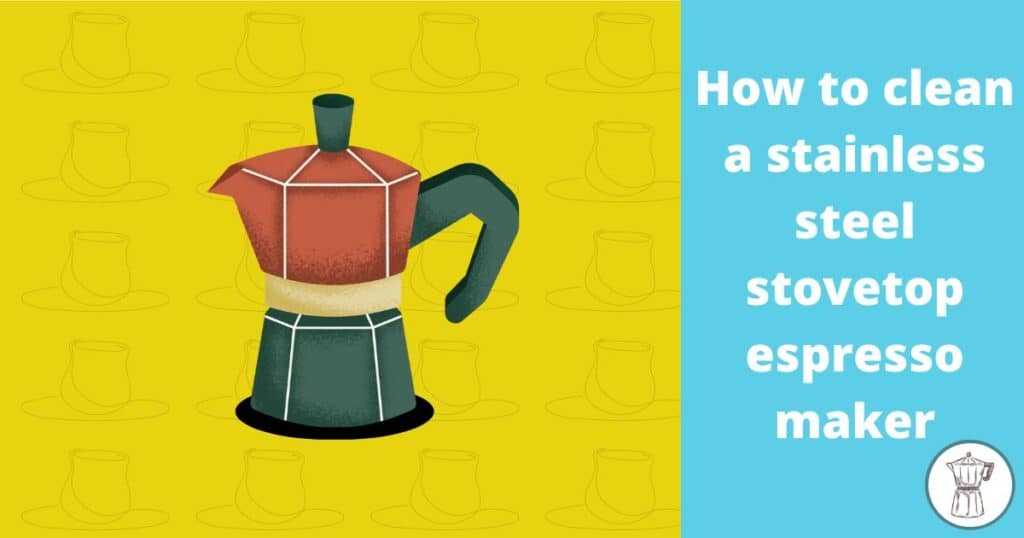Do you know how to clean a stainless steel stovetop espresso maker?
The other day I wanted to clean my Stovetop espresso maker properly but wasn’t sure how to go about it.
The bad thing with cleaning your Moka pot is that there’s a lot of contradictory information on the internet. For example, some suggest not washing it.
The good thing?
I did some research online and found a bunch of great tips and tricks that helped me make my stovetop espresso maker look brand new.
Stick around I’m going to unveil all the tips I learned so you can clean yours properly too.
Key takeaways:
- 3 reasons why the safety valve stops working
- Top tips and tricks on how to descale a Moka pot
- The best way to clean a Moka with burned coffee on it
How to clean your stovetop espresso maker (Moka pot)?
Stainless stovetop espresso maker
If your Moka pot is made of stainless steel the best way to go about it is to wipe it with a clean cloth that should be wet with hot water.
Coffee lover who owns his Moka pot reveals his cleaning method:
I was under the impression, like most people, that once the coffee is brewed, you just rinse the moka pot under hot water, and maybe use something non-abrasive such as a paper towel, WITHOUT SOAP, to clean the moka pot. This is to stop/reduce the amount of aluminum leeched into the coffee which 1) helps to keep the coffee from tasting metallic and 2) you won’t be drinking trace metals. But then I ran to the coffee expert James Hoffmann who said this is nonsense, that the coffee oils become rancid and add to the bitterness.
– r/Coffee
Are there still some stubborn stains?
Add some washing-up liquid (about 1-2 drops) in the hot water, dip your cloth again into it and go for another wiping round. This will remove all the stains oils and lipids coffee leaves on coffee gadgets.
It’s also a great idea to disassemble your Moka pot for cleaning it more thoroughly.
Give the gasket and funnel a proper wash and rinse it to keep your Moka pot in top condition.
Aluminium stovetop espresso maker
If your Moka pot is made of aluminium using vinegar is a great way to make your Moka pot look brand new.
Let’s have a look:
Blend hot water with vinegar (preferably white) place a cloth into the mixture and wipe the surface of your Moka pot. All the stains will be gone.
It’s vital to remove the espresso puck and clean the funnel thoroughly.
3 Reasons that make the safety valve isn’t working properly
Let’s go over 3 common reasons that the safety valve of your stovetop espresso brewer isn’t working properly.
1. Too much water when brewing
It’s vital to be aware of how much water you need every time you brew coffee. If you add too much water every time you pull an espresso shot, the chances are that you cover the valve that’s on the side of your Moka pot and it can’t really release steam. Make sure you use the right amount of water each time. Typically this is 150g of water, but if you can’t measure the water just put enough water that is right under the valve.
2. The valve is blocked with used coffee grounds
If you don’t clean and descale your Moka pot regularly, chances are that used coffee grounds will end up in the valve causing malfunctioning. If this is the case, it’s wise to clean your Moka pot regularly (I’d say once in 2 months). To unblock a blocked valve I suggest you use a brush for espresso wands.
3. Compressing coffee grounds
This is a key part when brewing with an espresso machine; you use a tamp to compress the coffee grounds and make them fit perfectly in the group. But you don’t need to do this with a Moka pot. It blocks the funnel and inevitably it makes it harder for the valve to let the steam out, meaning that your Moka pot should work harder to pull an espresso shot.
The table below summarises the 3 reasons and the solutions for each:
| Reason | Solution |
| Water above the valve | Make the water you place in the pot doesn’t exceed the valve |
| Blocked valve with coffee residue | Use a thin brush to unblock the valve so steam comes out when brewing |
| Tamping coffee grounds | Unlike espresso makers, when brewing with a Moka pot you don’t need to tamp the coffee grounds |
How to descale your Moka pot?
Did you know that 97% of a cup of coffee or an espresso shot is water?
And the problem with water (depending on the sort of water you use for brewing) has minerals that clog your Moka pot over time and make it work harder to brew espresso.
Vinegar again is the answer to descaling your Moka pot.
All you need to do is:
- Blend water with vinegar (equal parts) and pour the mix into the top part of your Moka where the water goes.
- Place it on a stove and turn it on
- Once all the blend of water and vinegar has gone on the top bit of your Moka pot you’re good to go.
- Repeat 1 more time the above steps for better results
- Throw the blend away and rinse your Moka pot to get rid of the vinegar smell
Top tip: you don’t need to add any coffee grounds when you descale your Moka pot – it should just be the mix of water and vinegar.
How to clean a burned Moka pot
If you have left your Moka pot longer to brew coffee and has burned coffee all over it it’s no good.
But there is a way you can clean it and make it look shiny:
- Disassemble all the Moka pot parts and soak all of them in a bowl with water and vinegar (equal parts).
- Give it about a day and use a cloth to wipe the surface of the Moka pot to remove all the stains
- Let all the bits of the Moka pot dry out, put them back together and you’re good to go

How to make your Moka pot ready for brewing?
Here’s where to start if your stovetop espresso brewer (Moka pot) is brand new:
- Give your Moka pot a quick wash (preferably with hot water)
- Brew 2-3 time espresso and throw it away and you’re good to go
Let’s wrap it up
Who likes cleaning? I personally try to avoid it as much as I can, but because I love coffee so much I can’t let my stovetop espresso maker be dirty and full of used coffee grounds and oils all over it. Cleaning your coffee gadgets is a way to show how much you love coffee. Go ahead and read about how to correctly clean an espresso maker with vinegar.

- How to Remove Coffee Stains From Countertop The Easy Way - December 21, 2023
- Can You Reuse Coffee Grounds in French Press? Truth Inside - December 12, 2023
- Can Expired Coffee Creamer Make You Sick? 3 Ways to Find Out - December 9, 2023
